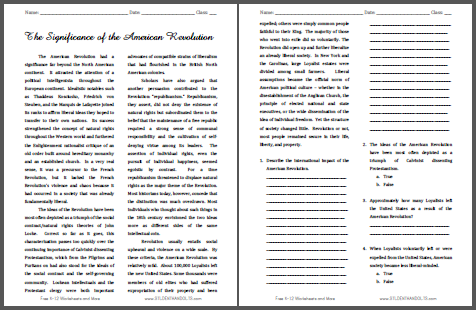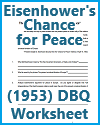| The Significance of the American Revolution Reading with Questions |
|---|
| www.studenthandouts.com ↣ American History ↣ American History Readings with Questions |
 The American Revolution had a significance far beyond the North American continent. It attracted the attention of a political intelligentsia throughout the European continent. Idealistic notables such as Thaddeus Kosciusko, Friedrich von Steuben, and the Marquis de Lafayette joined its ranks to affirm liberal ideas they hoped to transfer to their own nations. Its success strengthened the concept of natural rights throughout the Western world and furthered the Enlightenment rationalist critique of an old order built around hereditary monarchy and an established church. In a very real sense, it was a precursor to the French Revolution, but it lacked the French Revolution's violence and chaos because it had occurred in a society that was already fundamentally liberal.
The American Revolution had a significance far beyond the North American continent. It attracted the attention of a political intelligentsia throughout the European continent. Idealistic notables such as Thaddeus Kosciusko, Friedrich von Steuben, and the Marquis de Lafayette joined its ranks to affirm liberal ideas they hoped to transfer to their own nations. Its success strengthened the concept of natural rights throughout the Western world and furthered the Enlightenment rationalist critique of an old order built around hereditary monarchy and an established church. In a very real sense, it was a precursor to the French Revolution, but it lacked the French Revolution's violence and chaos because it had occurred in a society that was already fundamentally liberal.The ideas of the Revolution have been most often depicted as a triumph of the social contract/natural rights theories of John Locke. Correct so far as it goes, this characterization passes too quickly over the continuing importance of Calvinist dissenting Protestantism, which from the Pilgrims and Puritans on had also stood for the ideals of the social contract and the self-governing community. Lockean intellectuals and the Protestant clergy were both important advocates of compatible strains of liberalism that had flourished in the British North American colonies. Scholars have also argued that another persuasion contributed to the Revolution: "republicanism." Republicanism, they assert, did not deny the existence of natural rights but subordinated them to the belief that the maintenance of a free republic required a strong sense of communal responsibility and the cultivation of self-denying virtue among its leaders. The assertion of individual rights, even the pursuit of individual happiness, seemed egoistic by contrast. For a time republicanism threatened to displace natural rights as the major theme of the Revolution. Most historians today, however, concede that the distinction was much overdrawn. Most individuals who thought about such things in the 18th century envisioned the two ideas more as different sides of the same intellectual coin. Revolution usually entails social upheaval and violence on a wide scale. By these criteria, the American Revolution was relatively mild. About 100,000 Loyalists left the new United States. Some thousands were members of old elites who had suffered expropriation of their property and been expelled; others were simply common people faithful to their King. The majority of those who went into exile did so voluntarily. The Revolution did open up and further liberalize an already liberal society. In New York and the Carolinas, large Loyalist estates were divided among small farmers. Liberal assumptions became the official norm of American political culture—whether in the disestablishment of the Anglican Church, the principle of elected national and state executives, or the wide dissemination of the idea of individual freedom. Yet the structure of society changed little. Revolution or not, most people remained secure in their life, liberty, and property. Click here to print. Answer Key: (1) Answers will vary. It attracted the attention of the European political intelligentsia; strengthened the concept of natural rights; furthered the Enlightenment rationalist critique of the old order; helped to inspire the French Revolution and Latin American independence movements, (2) B - False, (3) 100,000, (4) B - False. |
 |  |  |  |  |
| www.studenthandouts.com ↣ American History ↣ American History Readings with Questions |








